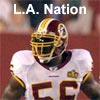March 7, 2004
Redskins' Brain Trust Burned Midnight Oil and Boss's Cash
By DAMON HACK
he clocks at Redskin Park read 12:01 a.m.
It was last Wednesday, the first minute of the free-agent period, a time for ambition.
Vinny Cerrato, Washington's vice president for football operations, sat with the people in the personnel department and prepared the hunt.
"We started in," Cerrato said over the telephone Friday, describing the scene. "Every position had a ranking. Our motto was, `Who do we want?' and then we just attacked. We left at 6:15 in the morning, went home and showered, and then we came back. Our hit list was character guys, football ability, workout ability and them wanting to be here. All A-pluses."
The list, upon completion, was passed on to the owner Daniel Snyder, whose private jet has burned a lot of fuel ferrying prospective Redskins to and fro.
"He cuts the deals," Cerrato said.
Days into another free-agent market, the Redskins have again assumed their place as the off-season's biggest noisemakers, hauling in talent of the highest grade in an attempt to return to the playoffs, from which they have been absent since the 1999 season.
One by one, the marquee names have signed on and smiled for the camera during introductory news conferences. Mark Brunell, the veteran quarterback, arrived via a trade from Jacksonville saying there was no place he would rather be than Washington.
Running back Clinton Portis, believing the future is so bright, wore shades.
"Dan Snyder is the owner that every player in the N.F.L. wants to play for," Portis said of his deep-pocketed boss.
The scene would have been remarkable if it had not occurred so many times in the past, with the Redskins loudly clearing their throats in the spring, then whispering through the fall and the winter.
Last year, the Redskins imported more than a dozen new faces. Receiver Laveranues Coles and three of his former Jets teammates headlined the class, but the team still finished 5-11 and facilitated Steve Spurrier's resignation as coach.
In 2000, the Redskins threw money at aging players like defensive end Bruce Smith and cornerback Deion Sanders, a tactic that Snyder later admitted was a mistake.
But in 2004, there is a feeling at Redskins Park that the team's most critical free-agent acquisition wears glasses and is grayer than when the N.F.L. last saw him.
The Redskins are building around the return of Coach Joe Gibbs, who led Washington to four Super Bowl appearances in 12 seasons between 1981 and 1992, and three titles.
Gibbs, upon his return, has a veteran quarterback in Brunell and one of the game's best running backs in Portis. There is firepower at receiver. The offensive line is intact.
Washington also snatched cornerback Shawn Springs, defensive tackle Cornelius Griffin, linebacker Marcus Washington and defensive end Phillip Daniels through free agency.
While Spurrier's coaching staff tended toward former college coaches who lacked major N.F.L. experience, Gibbs has veteran N.F.L. coaches like Joe Bugel (assistant head coach/offense) and Gregg Williams (assistant head coach/defense) at his side.
That difference should manifest itself on the field. Gibbs has long preached the running game. Spurrier preferred a wide-open passing attack.
"The biggest difference in the two is that, with Coach Gibbs, we use more tight ends and with Coach Spurrier we used more wide receivers," Cerrato said. "With both, we were always looking for good defensive players."
To build this new roster and stay under the $80.6 million salary cap, the Redskins created cap space by releasing several players, including Smith, who became the league's career sacks leader in 2003; and linebacker Jessie Armstead, whom the Redskins had signed with great fanfare in 2002.
And although the Redskins are paying nearly $50 million in signing bonuses for their six new acquisitions, the bonuses are prorated over the term of the contracts.
This method has risk, though. If, say, Portis ($17 million signing bonus) or Brunell ($8.6 million signing bonus) is released before his contract ends, the remaining bonus will accelerate against the cap, leaving the Redskins financially hamstrung.
The positive of the megasignings? The roster, on paper at least, is deep and ready-made for a playoff run.
"Dan obviously does what the coach wants to do," one National Football Conference East team executive said. "Dan is not going to go out picking stars out of the sky. These are the people the coach asks him to get. He sends his plane and he pays the coaches and the assistant coaches money to come in and coach."
Gibbs told The Associated Press: "Each team looks at it totally different, where they're going to spend the money, where they think they can help themselves the most. I think that's the neat part of it."
While Spurrier took the Redskins' job promising he would not work long hours, the 63-year-old Gibbs is back in the grind.
From Feb. 9-17, with a day off on Sunday, Cerrato, Gibbs and the entire personnel department worked from 8:30 a.m. to 11 p.m., watching film, evaluating players and plotting strategy. They ate pizza and peanuts.
"And a lot of coffee and tea to stay awake," Cerrato said.
These were the days that Cerrato saw Gibbs up close, when sight turned into the belief that the Redskins had gone about things the right way.
"He didn't miss a second," Cerrato said. "I do believe having the experienced coaching staff — an outstanding staff — will make the players even better. I believe it can take these guys to another level. But this still comes down to how many games you win in the fall. You silence the critics when you win, and the biggest thing we have to do is win football games now."
http://www.nytimes.com/2004/03/07/sport ... 07NFL.html








